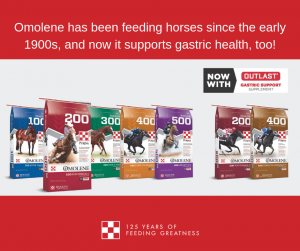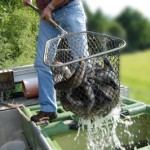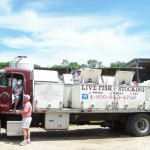 When choosing a horse feed, looking at the guaranteed analysis can help you determine if the nutritional content of that feed is appropriate for the age and activity level of your horse. You’d think that two products that both contain 14% protein, 6% fat, etc. would be pretty much the same feed. However, products with similar guaranteed analyses may be manufactured using different formulation strategies and have very different formulas. This can affect the nutritional value for your horse. The most common formulation strategies are “Least-cost” formulas and “Fixed” or “Locked” formulas. Both strategies have benefits and drawbacks. There is a formulation strategy that Purina uses for premium horse feeds, “Constant Nutrition” formulation, which is more nutritionally accurate than either of the other strategies.
When choosing a horse feed, looking at the guaranteed analysis can help you determine if the nutritional content of that feed is appropriate for the age and activity level of your horse. You’d think that two products that both contain 14% protein, 6% fat, etc. would be pretty much the same feed. However, products with similar guaranteed analyses may be manufactured using different formulation strategies and have very different formulas. This can affect the nutritional value for your horse. The most common formulation strategies are “Least-cost” formulas and “Fixed” or “Locked” formulas. Both strategies have benefits and drawbacks. There is a formulation strategy that Purina uses for premium horse feeds, “Constant Nutrition” formulation, which is more nutritionally accurate than either of the other strategies.
Least-cost formulation allows a manufacturer to adjust the ingredients in the formula based on cost. As long as the formula still meets the guaranteed analysis, the manufacturer can change the ingredients used in the formula. In some circumstances, the change in ingredients doesn’t change the effectiveness of the diet so it makes sense to meet the nutritional needs of the animal in the least expensive way. There would be no benefit to making a more expensive ration to achieve the same results. For instance, if you are feeding cattle and being paid for weight gain and a least-cost formula will not change the rate of gain or feed efficiency of the cattle, but will be less expensive to feed, that just makes good business sense. However, in some cases, especially when feeding horses, a major change in ingredients can dramatically alter the effectiveness of the diet, even when the nutrient levels don’t change. A good example of this would be substituting cottonseed meal for soybean meal in a diet for growing horses. Soybean meal and cottonseed meal may both have similar total protein content and could be interchangeable in a formula to meet the protein guarantee. However, cottonseed meal does not provide the same quality of protein to support growth as soybean meal, and young horses will not grow as well eating a feed with cottonseed meal as the protein source. So, in this case, the least-cost formula may be less expensive per ton but the loss in animal performance will negate any cost savings. In addition to potential for reduced performance, there is always the potential for reduced palatability or digestive upset in horses when large shifts in ingredients occur in their feed.
With fixed or locked formulas, the same ingredients and amounts of ingredients are used every time the feed is made, regardless of price or nutritional variation of those ingredients. This sounds like the most consistent way to make horse feed; however, there is a significant drawback. All ingredients, even high quality ingredients, have variation in nutritional content. For instance, all oats will not have the same protein or mineral content. If the formula is completely locked and not taking into account the nutritional content of the individual ingredients, the level of nutrition provided in the finished product will vary. Horses do benefit from consistency in their diets, but they don’t have specific requirements for certain ingredients. The purpose of ingredients is to provide nutrients the horse needs. So, while a fixed formula does provide the same amount of ingredient in every bag, it may not provide the same level of nutrition. For example, a horse feed made of 49% oats, 20% beet pulp, 16% corn, 8% alfalfa and 7% soybean meal would average 14% protein, using the average book values for these ingredients. However, with the typical range in protein content of these ingredients, the end product could range from 12.4% to 21.1% protein. Other nutrient levels will vary as well. So, while a fixed formula does insure a consistent ingredient profile, it won’t provide the most consistent level of nutrition for the horse.
“Constant Nutrition” formulation is a key component of the Purina FeedGuard™ Nutrition System. This strategy provides consistent, reliable nutrition in every bag of premium Purina horse feed. Under the Purina FeedGuard™ Nutrition System, stringent quality standards are set for ingredients which are purchased only from an approved list of suppliers that meet those strict criteria. Then, when ingredients arrive at a manufacturing facility, the ingredients are inspected, sampled and analyzed for nutrient levels. This is more accurate than using published book values or supplier averages for nutrient levels of ingredients. If an ingredient is approved, then the tested nutritional content is entered into the formulation system, which then makes small adjustments in amounts of ingredients to maintain consistent nutrient concentrations in the finished product. There are strict restrictions for how much adjustment is allowed to ensure consistency in formulation. For example, the amount of soybean meal may be adjusted slightly to compensate for lower protein in another ingredient, but cottonseed meal could not be substituted for soybean meal. This formulation strategy ensures that horses always receive the most consistent nutrition possible, and that horse owners always get exactly what they pay for.
Source: Karen E. Davison, Ph.D.
Manager- Equine Technical Services
Land O’Lakes Purina Feed


